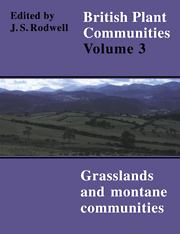Book contents
- Frontmatter
- Contents
- List of Figures
- Preface and Acknowledgements
- Preamble
- Mesotrophic Grasslands
- Community Descriptions
- Calcicolous Grasslands
- Community Descriptions
- Calcifugous Grasslands and Montane Communities
- Community Descriptions
- Index of Synonyms to Grasslands and Montane Communities
- Index of Species in Grasslands and Montane Communities
- Bibliography
U16 - Luzula Sylvatica-Vaccinium Myrtillus Tall-Herb Community
Published online by Cambridge University Press: 04 July 2020
- Frontmatter
- Contents
- List of Figures
- Preface and Acknowledgements
- Preamble
- Mesotrophic Grasslands
- Community Descriptions
- Calcicolous Grasslands
- Community Descriptions
- Calcifugous Grasslands and Montane Communities
- Community Descriptions
- Index of Synonyms to Grasslands and Montane Communities
- Index of Species in Grasslands and Montane Communities
- Bibliography
Summary
Synonymy
High cliff vegetation Petch 1933; Luzula sylvatica grassland McVean 1961, McVean & Ratcliffe 1962; Herb-rich birchwood, Vaccinium-Luzula treeless facies McVean & Ratcliffe 1962; Luzula sylvatica-Vaccinium myrtillus Association Birks 1973, Prentice & Prentice 1975; Agrostis-Luzula sylvatica nodum Prentice & Prentice 1975; Luzula sylvatica nodum Prentice & Prentice 1975; Luzula sylvatica-Vaccinium vegetation Jermy & Crabbe 1978; Luzula sylvatica grassland Association Jermy & Crabbe 1978; Luzula sylvatica-Vaccinium myrtillus nodum Huntley 1979; Cicerbita alpina tail-herb ledge Huntley 1979.
Constant species
Deschampsiaflexuosa, Galium saxatile, Luzula sylvatica, Vaccinium myrtillus.
Rare species
Cicerbita alpina, Salix lanata, S. lapponum, S. myrsinites, S. reticulata.
Physiognomy
Luzula sylvatica is an occasional, and sometimes locally abundant, plant in a variety of upland grasslands and heaths but it is in this Luzula-Vaccinium myrtillus community that it makes its most consistently prominent contribution outside the confines of woodlands and scrub. It is generally the most abundant plant here, occasionally an overwhelming dominant in swards with but few sparse associates and, even where other species are more numerous and extensive in their cover, there is not usually that richness and variety in the flora that is characteristic of much of the Luzula-Geum rivale community, our other widespread tail-herb vegetation with the club-rush on mountain ledges and crags. One plant that is more important in the Luzula-Vaccinium community, however, is V. myrtillus, frequent among all but the most luxuriant growths of L. sylvatica, and often occurring as quite vigorous bushes, a few decimetres tall, sometimes forming an irregular second tier to the vegetation, usually intermixed as clumps among the clubrush tussocks, and quite commonly co-dominant. Other sub-shrubs figure only occasionally and usually with but moderate abundance: V. vitis-idaea, Erica cinerea and Empetrum nigrum all occur infrequently and in small quantities, and there may be a little Calluna vulgaris, particularly where stands occur among heath-covered slopes, where heather bushes become more common in the transitional zone (e.g. Jermy & Crabbe 1978). Then, there are sometimes bushes of Salix aurita and Arctic-Alpine willows, like S. lapponum, S. lanata or S. myrsinites, or small patches of S. reticulata, and these may thicken up locally in zonations to Salix-Luzula scrub, the understorey of which shows strong floristic continuity with the Luzula-Vaccinium community.
- Type
- Chapter
- Information
- British Plant Communities , pp. 452 - 460Publisher: Cambridge University PressPrint publication year: 1992

